Karnataka Class 9 Maths Model Question Papers Set 2
Choose the correct alternative and Write the complete Solution along with its alphabet in the sheet provided:
Question 1. Which of the following is a set of rational nos.
- w = {0,1,2,3, }
- 2 = {….,-3,-2,-1,0,1,2,3,…….}
- \(q=\left\{\frac{p}{q} ; p, q \in \mathrm{I}, q \neq 0\right\}\)
- N= {1,2,3……..}
Solution : 3. \(q=\left\{\frac{p}{q} ; p, q \in \mathrm{I}, q \neq 0\right\}\)
Question 2.The degree of the polynomial x3 + x2+ 2x + 3 is
- 2
- 1
- 3
- 0
Solution : 3. 3
Karnataka 9th Standard Maths Model Question Paper 2023 Set 2 Free PDF
Question 3.When the polynomial p(y) =y3+ y2 – 2y +1 is divided by (y + 3) then remainder is
- 11
- -11
- 10
- -10
Solution: 2. -11
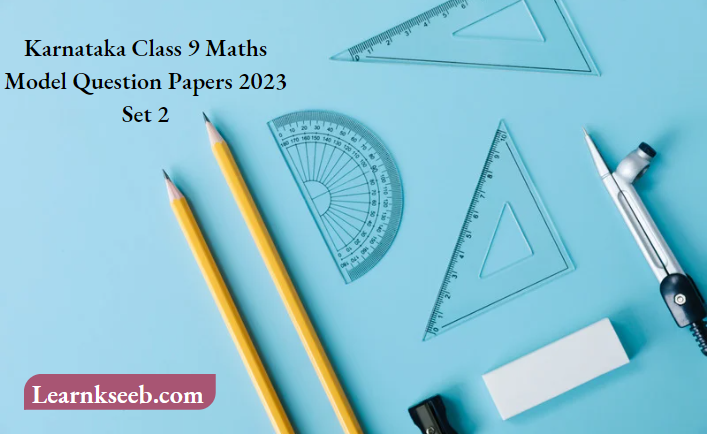
Question 4. The expanded form of (a -b) is
- a3 +b3 +3ab
- a3 – b3 – 3ab
- a3+b3 + 3a2b + 3ab2
- a3 -b3 +3a2b + 3ab2
Solution: 4. a3 -b3 +3a2b + 3ab2
Question 5. In fig, PQ and RS are two lines intersecting at O.
If \(\text { POR }=50^{\circ}\). find \(\text { QOS, }\) \(\text { |POS }\)

- 50°, 80°
- 50°, 130°
- 50°, 90°
- 50°, 100°
Solution: 2. 50°, 130°
Question 6. Area of a triangle =
- 1/2 x base * height
- 1/2 x height
- 1/2 x base
- base x height
Solution: 1. 1/2 x base x height
Class 9 Karnataka Maths Model Question Paper 2023 Set 2 with Solutions
Question 7.In fig. D is the midpoint of the side AB. DE || BC and EFIIAB. then DE =

- BC
- 1/2 AE
- 1/2 BC
- 1/2 FC
Solution: 3.1/2 BC
Question 8. In the given figure, ABCD is a parallelogram. If \(\mid \mathrm{ABC}\)= 125° and |DCA – 25°, then |DAC is
- 125°
- 40°
- 25°
- 30°
Solution: 4. 30°
Question 9. If three or more points lie on the same line, then they are called _________ points.
- Collinear
- Non-collinear
- Intersecting
- Opposite
Solution: 1. Collinear
9th Standard Karnataka Maths Model Paper 2023 Set 2 Latest Exam Pattern
Question 10. 10a2 + 2a+ 5 is an example of
- Trinomial
- Binomial
- Monomial
- Variable
Solution: 2. Binomial
Solution the following:
Question 1. Give one example each of a binomial of degree 5 and a monomial of degree 10.
Solution:
Binomial of degree \(5-x^5+x^4\)
Monomial of degree 10 – a10
Question 2. Simplify: \((x+\sqrt{y})(x-\sqrt{y})\)
Solution: \( (x+\sqrt{y})(x-\sqrt{y})=x^2-(\sqrt{y})^2=x^2-y\)
Question 3. Find the value of : \( \frac{11^{\frac{1}{2}}}{11^{\frac{1}{4}}}\)
Solution : \( \frac{11^{1 / 2}}{11^{1 / 4}}=11^{1 / 2-1 / 4}=11^{\frac{2-1}{4}}=11^{1 / 4} \)
Question 4. Find the value of K, if x-1 is a factor of p(x)
=\(\mathbf{k} x^2-\sqrt{2} x+1\)
Solution :
\(\begin{aligned}& \mathbf{p}(\boldsymbol{x})=k x^2-\sqrt{2} x+1 \\
& \mathrm{p}(1)=\mathrm{k}(1)^2-\sqrt{2}(1)+1 \\
& \mathrm{p}(1)=k-\sqrt{2}+1 \\
& 0=k-\sqrt{2}+1 \\
& \sqrt{2}-1=k
\end{aligned}\)
Question 5. Find any two solutions forx= 5y
Solution: x= 5y
x = 0, 0 = 5y
x = 1, 1= 5y
∴ y = 0 1/5 = y
(0,0) 0.2 = y
(1,0.2)
∴The two solutions are (0, 0) and (1, 0.2)
Question 6. Write any two postulates.
Solution:
- A straight line may be drawn from any one point to any other point.
- A circle can be drawn with any center and radius.
Question 7. In fig. find the value of x.

Solution: x= 90°
Question 8. In the adjoining figure, identify and write the name of the parallel sides and the alternate angles.

Solution: \(\mathrm{AB}\|\mathrm{CD}, \mathrm{AD}\| \mathrm{BC} \text { and }\lfloor\mathrm{BAC}=\lfloor\mathrm{DCA}\)
Question 9. In the fig, find the value of x.
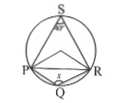
Solution: x = 80°
Question 10.In the fig |CAD = 55° and |BAC = 45°, then find the |DAB
Solution: |DAB = 100°
Answer the following:
Question 1. Construct \( \sqrt{2.7}\) on the number line
Solution:
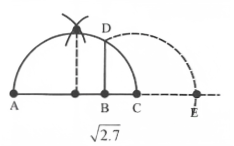
Question 2. Simplify : \((\sqrt{a}+7)(\sqrt{a}+\sqrt{8})\)
Solution:
\(\begin{aligned}& (\sqrt{a}+7)(\sqrt{a}+\sqrt{8}) \\
& =\sqrt{a}(\sqrt{a}+\sqrt{8})+7(\sqrt{a}+\sqrt{8}) \\
& =(\sqrt{a})^2+\sqrt{8} a+7 \sqrt{a}+7 \sqrt{8} \\
& =a+2 \sqrt{2 a}+7 \sqrt{a}+14 \sqrt{2}
\end{aligned}\)
Question 3. Find the remainder when t4+2 t2 + 5 is divided by x – 2
Solution:
\(\begin{aligned}\text { Let } \mathrm{p}(t) & =t^4+2 t^2+5 \\
\mathrm{p}(2) & =(2)^4+2(2)^2+5 \\
\mathrm{p}(2) & =16+8+5 \\
\mathrm{p}(2) & =29
\end{aligned}\)
Question 4. Expand(2x + 3y-5z)2 using a suitable identity.
Solution :
\(\begin{aligned}& (2 x+3 y-5 z)^2 \\
& (a+b+c)^2=a^2+b^2+c^2+ \\
& 2 a b+a b c+2 c a \\
& (2 x+3 y-5 z)^2=4 x^2+9 y^2+25 z^2 \\
& +12 x y-30 y z-20 x z \\
&
\end{aligned}\)
Karnataka Class 9 Maths Previous Year Model Paper 2023 Set 2 with Key Answers
Question 5. Express x + 6y = 7 in the form of ax + by + c – 0 and indicate the values of a, b and c.
Solution:
x + 6y = 7
x + 6y – 7 = 0
ax + by + c = 0
a = 1, b = 6, c = -7
Question 6.In fig. \(\mathrm{PQR}=\mathrm{PRQ}\), P then proves that \( \angle \mathrm{PQS}=\lfloor\mathrm{PRT} \)

Solution:
∴\(\quad \mathrm{PQR}+\mathrm{PQS}=180^{\circ} \ldots .(1) \text { (linear pair) }\)
Similarly \(\left\lfloor P R Q+\left\lfloor P R T=180^{\circ}\right.\right.\)
(2) (linear pair)
From (1) and (2)
\(\angle \mathrm{PQR}+\angle \mathrm{PQS}=\angle \mathrm{PQR}+\angle P R T\)∴\(\angle \mathrm{PQS}=\angle \mathrm{PRT}(\angle \mathrm{PQR}=\angle \mathrm{PRQ})
\)
Question 7. In fig. find the values of x andy and then S.T. AB || CD
Solution:
In the fig, 50°+ x = 180°
x = 180° — 50°
x = 130° also y = 130°
∴x = y = 130°(Alternative angle)
Since alternate angles are equal AB || CD
Question 8. The line is the bisector of an angle ∠ A and ∠ B is any point on l. BP and BQ are perpendiculars from B to the arms of |A. S.T.
- AAPB = AAQB
- BP = BQ
Solution:
In the fig line,’ l ‘ bisects ∠A,
BQ and BP are perpendicular to the arms of ∠A.

In △APB and △AQB
∠APB = ∠ABQ = 90° (given)
∠PAB = ∠QAB (l bisect ∠A)
AB = AB (common)
∴△APB ≅ △AQB (ASS congruence rule) BP = BQ (CPCT)
Question 9. Diagonal AC of a parallelogram ABCD bisects ∠A. S.T.
- It bisects ∠C also
- ABCD is a rhombus.
Solution:
In fig. AC bisects ∠A
∴∠DAC — ∠BAC ………. (1)
But ∠DAC — ∠BCA (Alternate angles)………….(2)
and ∠BAC — ∠DCA (Alternate angles)…………….(3)
From(1), (2), and (3)
∠BCA = ∠DCA
∴AC bisect ∠C
Also ∠DAC = ∠DCA (From(1), (2) and (3))
∴AD = DC
But AD = BC
and DC = AB
∴AD = BC = AD = BC
∴ABCD is a rhombus
Question 10. ABC is a right-angled triangle at C. A line through the midpoint M of hypotenuse AB and parallel to BC intersects AC at D. S.T.
CM = MA = 1/2 AB
Solution:
In the fig join CM.
M is the midpoint of AB
∴ MA = 1/2 AB……………………….. (1)
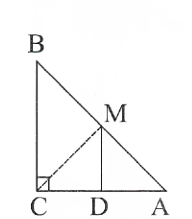
Now, In △AMD and △CMD
AD = DC
∠MDC = ∠MDA = 90°
MD = MD (common)
∴△AMD = △CMD (SAS congruence rule)
CM = MA (CPCT)……………….. (2)
comparing (1) and (2)
CM = MA = 1/2 AB
Karnataka 9th Maths Sample Paper 2023 Set 2 for Board Exam Preparation
Question 11.In fig. ABCD is a parallelogram, AE⊥DC and CF ⊥ AD • If AB = 16cm, AE = 8cm and CF = 10cm d E find AD.
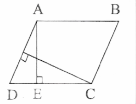
Solution:
In fig. ABCD is a parallelogram
Area of the ▱ABCD = base x height
= DC x AE
= 16 x 8
=128cm2
Area of ▱ABCD = b x h
128 – AD x 10
AD = 128/10
AD = 12.8cm
Question 12. S.T. the diagonals of a parallelogram divide it into four triangles of equal area

Solution:
ABCD is a parallelogram.
The diagonals AC and BD bisect each other at ’O’.
∴‘O’ is the midpoint of AC and BD
In △ADC, DO is the median on AC.
∴ar(△AOD) =ar{△COD)………. (1)
In ABDC j CO is the median on BD.
∴ar(△COD) = (△BOC)……………….(2)
In A ABC, BO if the median on AC
∴ar(△BOC) =ar(△AOB)……………….. (3)
In A ABD 5, AO is the median on BD
∴ar(△AOB) =ar(AOD)…………………….. (4)
comparing (1), (2), (3), and (4)
ar(△AOD) =ar(△COD)
=ar(△BOC)=ar(△AOB)
Question 13.In fig. ∠ABC-69°, ∠ACB = 31°, find ∠BDC
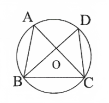
Solution:
In △ABC
∠BAC + ∠ABC + ∠ACB = 180°
69° + 31° + ∠BAC = 180°
100° + ∠BAC = 180°
∠BAC = 180° —100°
∠BAC = 80°
∠BAC = ∠ BDC
∴ ∠BDC = 80°
Question 14. Construct the angle of 15° and verify by measuring it with a protractor.
Solution :

Question 15. Give four examples of data that you can collect from your day-to-day life.
Solution:
- Number of T.V. viewers in a city
- The number of colleges in a city.
- Height of students in a class.
- The number of children in the country under 15 years.
Question 16. Eleven bags of wheat flour, each marked 5kg, actually contained the following weights of flour(in kg):
4.97; 5.05; 5.08; 5.03; 5.00; 5.06; 5.08; 4.98; 5.04; 5.07; 5.00 Find the probability that any. of these bags chosen at random contains more than5kg of flour.
Solution:
Total Number of bags =11
Number of bags containing more than 5 kg of flour = 7
∴ P(bags containing more than 5kg flour) = 7/11
Question 17. If two equal chords of a circle intersect within the circle, prove that the line joining the point of intersection to the center makes equal angles with the chords.
Solution:
In the circle ‘O’ is the
center of a circle Chord AB = Chord CD
Draw OP ⊥ CD and OQ ⊥ AB
In △OPE and △OQE ∠OPE = ∠OQE = 90°
OE = OE (common hypotenuse)
![]() OPE =
OPE =![]() QOE
QOE
(RHS congruence rule)
∴ ∠OEP = ∠OEQ (CPCT)
Question 18. Identify and write the name of the quadrilateral and triangle from fig.
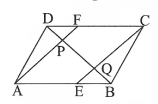
Solution:
Quadrilaterals ABCD and AECF
Triangles: △ADF, △EBC, △BDC, △BAD
Solution the following:
Question 1. Factorise : 27 x3 + y3+ z3 – 9xyz
Solution:
27 x3+ y3 + z3 — 9xyz
(3x)3 + y3 + z3 — 3(3x)y
x3 + y3+ z3 – 9xyz
(x2 + y2+z2— xy — yz — zx)
(3x)3 +y3 + z3— 3 xyz =
(3x + y + z) (9x2 + y2+z2 — 3 xy — yz — 3 zx)
Question 2. Draw the graph of x-y = 2
Solution :

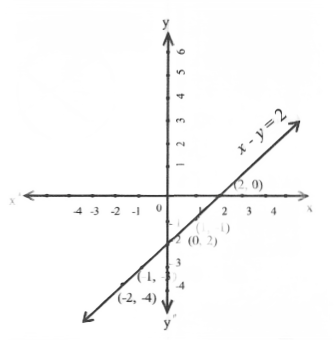
Question 3. In the figure, ray OS stands on a line POQ. Ray OR and ray OT are angle bisectors of ∠POS and ∠SOQ, respectively. If ∠POS – x, find ∠ROT.
Solution:
Ray OS stands on the line POQ
∠POS + ∠SOQ = 180°
x + ∠SOQ = 180°
∠SOQ = 180°—x
∠ROS = 1/2 x∠POS
= 1/2 x x
∠ROS = x/2
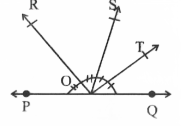
Similarly ∠SOT = 1/2 x∠SOQ
= 1/2x (l80° —x)
∠SOT = 90° – x/2
Now, ∠ROT = ∠ROS + ∠SOT
\(=\frac{x}{2}+90^{\circ}-\frac{x}{2}\)∠ROT = 90°
9th Class Karnataka Maths Model Paper 2023 Set 2 Important Questions
Question 4. Line segment AB is parallel to another line segment CD. D is the mid-point of AD. S.T.
- △AOB ≅ △DOC
- O is also the midpoint of BD.
Solution :
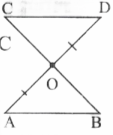
- consider △AOB and △DOC
∠ABO =∠DCO (AB || CD)
∠AOB – ∠DOC(V.O.A)
OA = OD (given)
∴△AOB ≅ ∠DOC (AAS rule) - OB = OC (CPCT)
∴O is the midpoint of BC.
Question 5. In a parallelogram ABCD, E and F are the midpoints of sides AB and CD respectively. S.T. the line segments AF and EC trisect the diagonal BD.
Solution:
ABCD is a parallelogram
AB || DC and AB = DC
∴ 1/2 AB = 1/2 Dc
AE = CF and AE || CF (AB || CD)
∴ In the quadrilateral AECF
AE || CF and AE = CF
∴ AECF is a parallelogram
∴ AF || EC
In △DQC , PF || QC (•.• AF || EC) and F is the midpoint of DC
∴ P is the midpoint of DQ
△DQC DP = PQ…………………………… (1)
In △DAP, EQ [| AP (AF || CE)
‘E’ is the midpoint of AB
∴ Q is the midpoint of BP
PQ = BQ ……………………………(2)
From (1) and (2)
DP = PQ = BQ
∴Line segments AF and EC trisect the diagonal BD.
Question 6. The inner diameter of a circular well is 3.5m. It is 10m deep. Find
- Its inner curved surface area,
- The cost of plastering this curved surface at the rate of ₹40 per nr.
Solution:
The inner diameter of the well = 3.5m
r = 3.5/2 m
- Inner CSA of the well = 2πrh
= \(22 \times \frac{22}{7} \times \frac{3.5^{0.5}}{2} \times 10\)
= 110m2 - cost ofplastering the inner CSA at ₹40m2 = 110×40 =₹4400
Solution the following :
Question 1. The following table gives the distribution of students in two sections according to the marks obtained by them.
Section A Section B
Marks Frequency Marks Frequency
0-10 3 0-10 5
10-20 9 10-20 19
20-30 17 20-30 15
30 – 40 12 30-40 10
40-50 9 40-50 1
Represent the marks of the students of both sections on the same graph by two frequency polygons. The two polygons compare the performance of the two sections.
Solution:
Scale x – axis 1cm= 5units
y-axis 1cm= 3 units
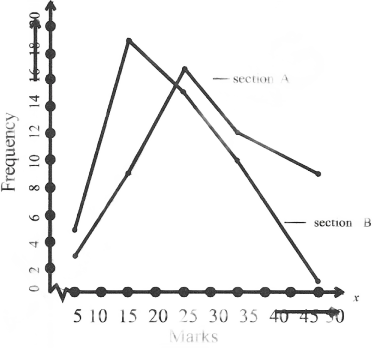
Latest Karnataka Class 9 Maths Model Papers 2023
Question 2.Prove that the line of centers of two intersecting circles subtends equal angles at the two points of intersection
Solution: Let two circles with respective centers A and B intersect each other at points C and D.
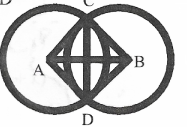
In A ABC and AABD AC =AD (radii)
BC = BD (radii)
AB = AB (common)
∴△ABC ≅ △ABD (By SSS congruence mle)
⇒∠ACB = ∠ADB (CPCT)
Question 3.Factorise : x3 – 3x2 – 9x – 5
Solution:
Let p(x) = x3 – 3x2 – 9x – 5
By trial, we find that p(-l) = (-1)3-3(-1)2-9(-l)-5
= -1-3+9-5
= 0
∴(x + 1) is a factor of this polynomial.
Let us find the quotient for dividing
x3 + 3x2 – 9x – 5 by (x+1) by long division method.
\(\begin{aligned}& x+1) \frac{x^2-4 x-5}{x^6-3 x^2-9 x-5} \\
& \frac{\left.\frac{(-) x^8+x^2}{(-1}\right)}{4 x^2-9 x-5} \\
& \frac{(+) 4 x^2 \frac{-4 x}{(+)}}{-5 x-5} \\
&
\end{aligned}\)
∴ quotient= x2 -4x – 5
Now factorise the, x3 _ 3X2 _ 9X_ 5
x2(x+l)- 4x(x+1)- 5(x+1)
= x2(x+1)- 4x(x+1)- 5(x+ 1)
= (x+l)(x2-4x-5) + (x+l)(x2– 5x+ x- 5)
= (x+ 1) {x (x- 5)+l(x- 5)}
= (x+l) (x-5) (x+l)
Karnataka Board 9th Class Maths Model Question Paper 2023 Set 2 Solved PDF
Question 4. Prove that “parallelograms on the same base and between the same parallels are equal in area.”
Solution:
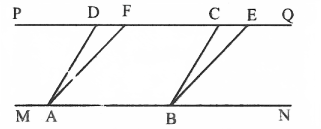
Data: Parallelogram ABCD and ABEF standing on the same base AB and between the parallels PQ and MN.
To prove : ar(ABCD) = ar(ABEF)
Proof: In ΔADF and ΔBCE
∠ADF = ∠BCE (corresponding angles)
∠AFP = ∠BEC (corresponding angles)
DF = CE
∴ ΔADF ≅ ΔBCE
ar (ΔADF ) = ar ΔBCE
consider fig. ABED
area (ABED) – area (BCE)
= area (ABED) – area (ADF)
area (ABCD) = area (ABEF)
∴area of ▱ ABCD = area of ▱ ABEF
